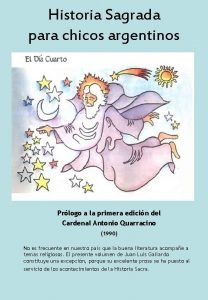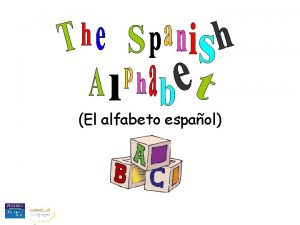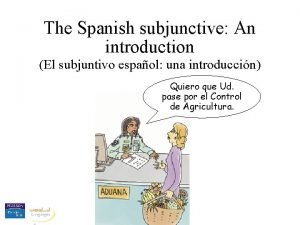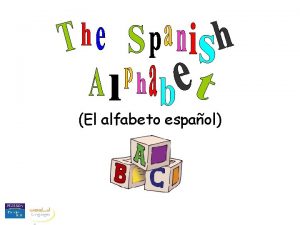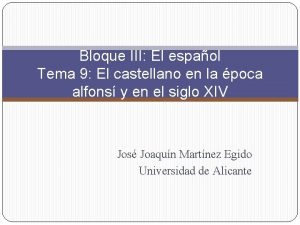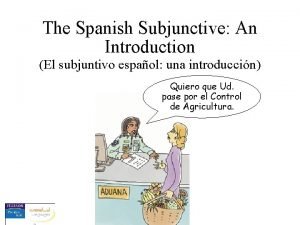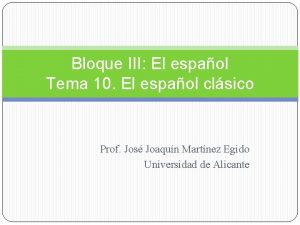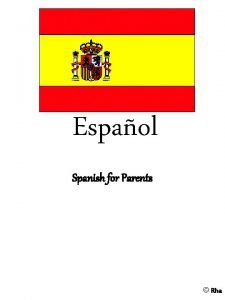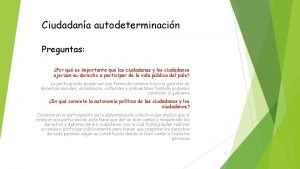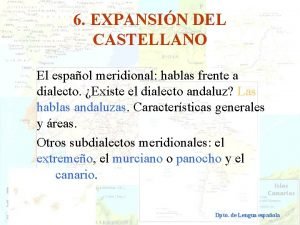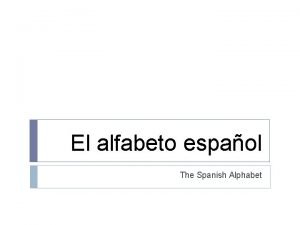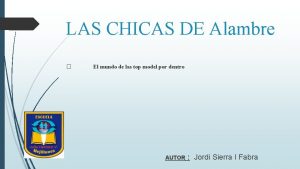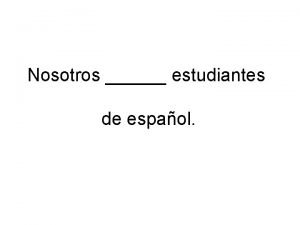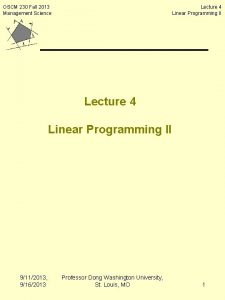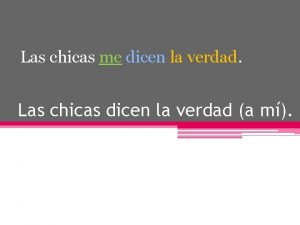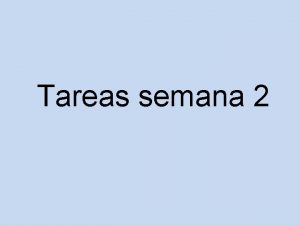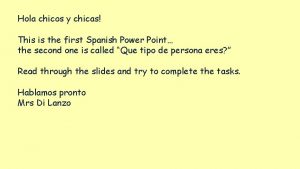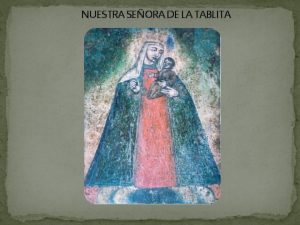Fall Review Seora Gaona Espaol Chicos y Chicas





















































- Slides: 53

Fall Review Señora Gaona Español

Chicos y Chicas… • Before you begin your day, remember what I expect from you as a class and as individual students. Be respectful, do what is asked of you, and work quietly.

Campanita • 1. Which word is masculine? • 2. Which word is feminine? • • la casa la mesa el libro la ventana • • el chico el hermano el abuelo la hermana

In Spanish, all nouns are either masculine or feminine. Masculine Feminine el chico la chica boy girl el jardín la universidad garden university el libro la revista book magazine el miedo la libertad fear liberty

• The idea that nouns have gender seems perfectly natural when the noun stands for a living creature. This is because in English, living creatures often have different names, depending upon whether they are male or female. • Masculine Feminine • man woman • tiger tigress

The following Spanish nouns all denote living creatures. Gato/Gata Perro/Perra Abuelo/Abuela

How are these nouns alike? • El perro/La perra • El chico/La chica • El abuelo/La abuela • El gato/La gata

"El" and "la" both mean "the. " el chico (the boy) la chica (the girl) el perro (the male dog) la gata (the female cat)

Nouns that end in -o are usually masculine. Nouns that end in -a are usually feminine. Notice the word usually! There are exceptions to these two rules and you will soon be learning them.

• One cannot predict the gender of a noun that stands for a non-living thing. Try to predict whether the Spanish words for the following things are masculine or feminine: • Masculine or feminine? • • book house money window

Take a guess. Do you think the Spanish word for "dress" is masculine or feminine? You might expect it to be feminine, since a dress is an article of clothing worn by females. Actually, the word for "dress" is a masculine word: el vestido

Take another guess. Do you think the Spanish word for "necktie" is masculine or feminine? You might expect it to be masculine, since a necktie is an article of clothing worn by males. Actually, the word for "necktie" is a feminine word: la corbata

• When you learn a new noun, you should also learn its definite article (el, la). There are several reasons for this: • • Because you cannot predict the gender of most nouns. Because not every noun that ends in -o is masculine, and not every noun that ends in -a is feminine. Because many nouns end in letters other than o or a. Because the definite article (el, la) is your clue as to whether a noun is masculine or feminine.

If a noun ends in a vowel, make it plural by adding -s. libro: libros (libro + s) pluma: plumas (pluma + s) chico: chicos (chico + s) señora: señoras (señora + s)


The definite articles (el, la) also change in the plural form. They become "los" and "las. " The definite articles will be covered in depth in the next lesson. el libro: los libros la pluma: las plumas el chico: los chicos la señora: las señoras

If a noun ends in a consonant, make it plural by adding -es. el borrador: los borradores (borrador + es) la universidad: las universidades (universidad + es) el profesor: los profesores (profesor + es) la ciudad: las ciudades (ciudad + es)

If a noun ends in -ión, add -es and drop the written accent. el avión: los aviones la conversación: las conversaciones la sección: las secciones la televisión: las televisiones

If a noun ends in -z, add -es and change the z to c. el lápiz: los lápices la voz: las voces la actriz: las actrices

When the plural refers to two or more nouns of different genders, the masculine plural is used. 2 perros + 6 perras = 8 perros (not perras) 1 gato + 8 gatas = 9 gatos (not gatas)

Here are the numbers 1 -10 1. uno 2. dos This is what you guys look like when I speak to you in Spanish 3. tres 4. cuatro 5. cinco 6. seis 7. siete 8. ocho 9. nueve 10. diez

The number "one" changes from "uno" to "un" before a masculine noun. un libro one book un perro one dog (male) un hombre one man

The number "one" changes from "uno" to "una" before a feminine noun. una pluma one pen una gata one cat (female) una chica one girl

When counting generically (one, two, three. . . ) use "uno" but when counting specifically (one cat, one dog), use "un" or "una. " un libro one book una pluma one pen uno, dos, tres one, two, three

A verb is an action word. run sit eat sink swim study

• The main form of a verb is called the infinitive. In English, infinitives include the word "to. " • • • to run to sit to eat to sink to swim to study

The infinitive is the pure form of a verb. The infinitive is like a lump of clay that can be molded to match the subject of the sentence it is used in: I speak you speak he/she speaks we speak you-all* speak they speak

• The words "I" "you" "he" "she" "we" "you-all" and "they" are called subject pronouns. Spanish has corresponding subject pronouns. Here's a list of the English subject pronouns and their Spanish equivalents:

Yo I Tú You usted you él he ella she nosotros we ustedes you-all Ellos they

Spanish subject pronouns are both similar to and different from their English counterparts. Let's examine some of the differences. Look more closely at the English word "you. " You have just seen that this can be translated into Spanish as "usted. " But there is also a second way it can be translated. There are two ways the English word "you" can be expressed in Spanish: usted you tú you

Spanish has a formal and an informal form of the word "you. " "Usted" is more formal and is generally used to express respect. "Tú" is more familiar and is used among friends, coworkers, relatives, or when addressing a child. Speaking to your boss: usted Speaking to your daughter: tú Speaking to your teacher: usted Speaking to your friend: tú

In many ways, Spanish is more gender-specific than English. We find evidence of this in the subject pronouns. First, look at the word "nosotros. " This means "we" in the sense of a group containing at least one male. If the group contains only females, the word "nosotras" is used. So, in Spanish, there are two ways to say "we": nosotros we (masculine or mixed group) nosotras we (feminine)

This same idea applies to the English word "they": ellos they (masculine or mixed group) ellas they (feminine)

Here's the complete list of Spanish subject pronouns: Singular yo - I tú - you (familiar) él - he ella - she usted - you (formal)

Plural nosotros we (masculine or mixed gender) nosotras we (feminine) vosotros you-all (familiar, Spain, masculine or mixed gender) vosotras you-all (familiar, Spain, feminine) ellos they (masculine or mixed gender) ellas they (feminine) ustedes you-all (formal in Spain, formal and familiar in Latin America)

GUSTAR • This is a good time to discuss the verb "gustar" because using it requires use of the IO pronouns. • • Me gusta el cuarto. I like the room. • • Nos gustan los libros. We like the books.

• In English, the following sentences are correct: • • I like the room. We like the books.

• Examine the same sentences more closely. • I like the room. • • • I = subject of sentence • We like the books. • • • We = subject of sentence like = verb the room = direct object like = verb the books = direct object

• n English, it is correct to construct a sentence that has the subject "liking" a direct object. In Spanish, this never occurs. In Spanish, a different construction is used. • • English: I like the room. • • English: We like the books. Spanish: The room is pleasing to me. Spanish: The books are pleasing to us.

• The first thing you need to notice is that both versions really mean the same thing. They are merely different expressions of the same idea. • Idea: My feelings with regard to the book are positive. • • English Way: I like the book. Spanish Way: The book is pleasing to me.

• The second thing to notice is that in English, the subject of the sentence is the person (I, we) while in Spanish the subject of the sentence is the object (room, books). • • The room is pleasing to me. • • I like the room. Subject: The room Subject: I

• Finally notice that while the English sentence has a direct object, the Spanish sentence has an indirect object. • • The room is pleasing to me. • • I like the room. me = Indirect Object room = Direct Object

• Let's study the following example: • Me gustan los libros. • • Literal Translation: To me the books are pleasing. Actual Translation: I like the books.

• Notice that gustar is conjugated as "gustan" not "gusto. " A common mistake is to say "Me gusto los libros. " This is incorrect because the subject of the sentence is "los libros" even though it comes at the end. Remember, the verb is conjugated to agree with the subject of the sentence. • Me gustan los libros. (I like the books. )

• Notice that the conjugation of gustar changes to "gusta" when the subject of the sentence is singular. • Me gusta el libro. (I like the book. )

• Since the subject of the sentence must be either singular (book) or plural (books), the only forms of gustar you will use are "gusta" and "gustan. " This is true regardless of what IO pronoun appears in the sentence. Me gusta el libro. I like the book. Me gustan los libros. I like the books. Te gusta el libro. You like the book. Te gustan los libros. You like the books. Nos gusta el libro. We like the book. Nos gustan los libros. We like the books.

Remember, gustar becomes either gusta or gustan, depending upon whether the subject of the sentence is singular or plural. It has nothing to do with which IO pronoun is used. • Subject is singular - use gusta • • Me gusta el libro. • Subject is plural - use gustan • • Me gustan los libros. Te gusta el libro. Te gustan los libros.

Ejemplos • • • Singular Subject Plural Subject Me gusta la casa. Me gustan las casas. Te gusta el cuarto. Te gustan los cuartos. Le gusta la silla. Le gustan las sillas. Nos gusta el hotel. Nos gustan los hoteles. Les gusta el reloj. Les gustan los relojes.

• Look more closely at one example: • Le gusta la silla. • It is impossible to tell whether this means: • • • He likes the chair. She likes the chair. You (usted) like the chair.

For purposes of clarification, the sentence will often begin with a prepositional phrase that clarifies just who the IO pronoun refers to. • • A él le gusta la silla. • • A Juan le gusta la silla. John likes the chair. • He likes the chair. • • A ella le gusta la silla. She likes the chair. • • A María le gusta la silla. Mary likes the chair. • • A usted le gusta la silla. You (formal) like the chair.

• You can also use a prepositional phrase to add emphasis, even if there is no ambiguity. • • 1. A Juan le gusta el café. • • 2. A mí me gusta el té. John likes coffee. I like tea.

• Now that you know how to correctly use the verb gustar, here is a list of verbs that operate in the same manner: • • • • aburrir to bore fascinar to be fascinating to importar to be important to caer bien (mal) to (not) suit interesar to be interesting to molestar to be a bother • • • • parecer to appear to be doler (o: ue) to be painful picar to itch encantar to "love" something quedar to be left over, remain faltar to be lacking something volver (o: ue) loco to be crazy about

www. senoralorena 201516. weebly. com Copy this website if you need to catch up or if you have missed notes from a previous day
 Definite and indefinite nouns
Definite and indefinite nouns Hoy
Hoy Necesitar (imperfect) los chicos
Necesitar (imperfect) los chicos Rosetta stone login portal
Rosetta stone login portal Historia sagrada para chicos argentinos
Historia sagrada para chicos argentinos Vowel + y
Vowel + y Trabajos en espaol birmingham
Trabajos en espaol birmingham Aprender espaol
Aprender espaol Espaol
Espaol Abecedario espaol
Abecedario espaol Spanish adjectives to describe yourself
Spanish adjectives to describe yourself Miguel hidalgo preguntas
Miguel hidalgo preguntas Cuales son las consonantes
Cuales son las consonantes El espaol
El espaol Espaol
Espaol Preguntas de ciudadania en espaol
Preguntas de ciudadania en espaol Penas graves
Penas graves Preparatic
Preparatic El espaol
El espaol En espaol
En espaol Puntos cardinales españa
Puntos cardinales españa Examen de ciudadana 2020 en espaol
Examen de ciudadana 2020 en espaol Idioma espaol
Idioma espaol Citizenship test en espaol
Citizenship test en espaol Preguntas para la ciudadana en espaol
Preguntas para la ciudadana en espaol Español meridional
Español meridional Complete spanish alphabet
Complete spanish alphabet Vanesa molins cadafalch
Vanesa molins cadafalch Todos los que estamos aqui somos estudiantes de espanol
Todos los que estamos aqui somos estudiantes de espanol Sierras chicas
Sierras chicas English 3 fall semester exam review
English 3 fall semester exam review Physics fall final exam review
Physics fall final exam review Ironydef
Ironydef Physics fall semester review answers
Physics fall semester review answers World history fall semester exam review
World history fall semester exam review Us history final exam
Us history final exam Chemistry fall semester exam review answers
Chemistry fall semester exam review answers Inclusion criteria examples
Inclusion criteria examples Chapter review motion part a vocabulary review answer key
Chapter review motion part a vocabulary review answer key Narrative review vs systematic review
Narrative review vs systematic review Uncontrollable spending ap gov
Uncontrollable spending ap gov Nader amin-salehi
Nader amin-salehi Mistdemon
Mistdemon What does ancient egypt
What does ancient egypt Fall of potential ground test
Fall of potential ground test Spring has sprung the grass
Spring has sprung the grass English 1010 slcc
English 1010 slcc Things fall apart as a tragedy
Things fall apart as a tragedy Fall 2013
Fall 2013 Things fall apart 14-19 summary
Things fall apart 14-19 summary The myth of daedalus and icarus summary
The myth of daedalus and icarus summary Things fall apart chapter 4 summary
Things fall apart chapter 4 summary Safety stickers
Safety stickers Richard nixon tricky dicky
Richard nixon tricky dicky




